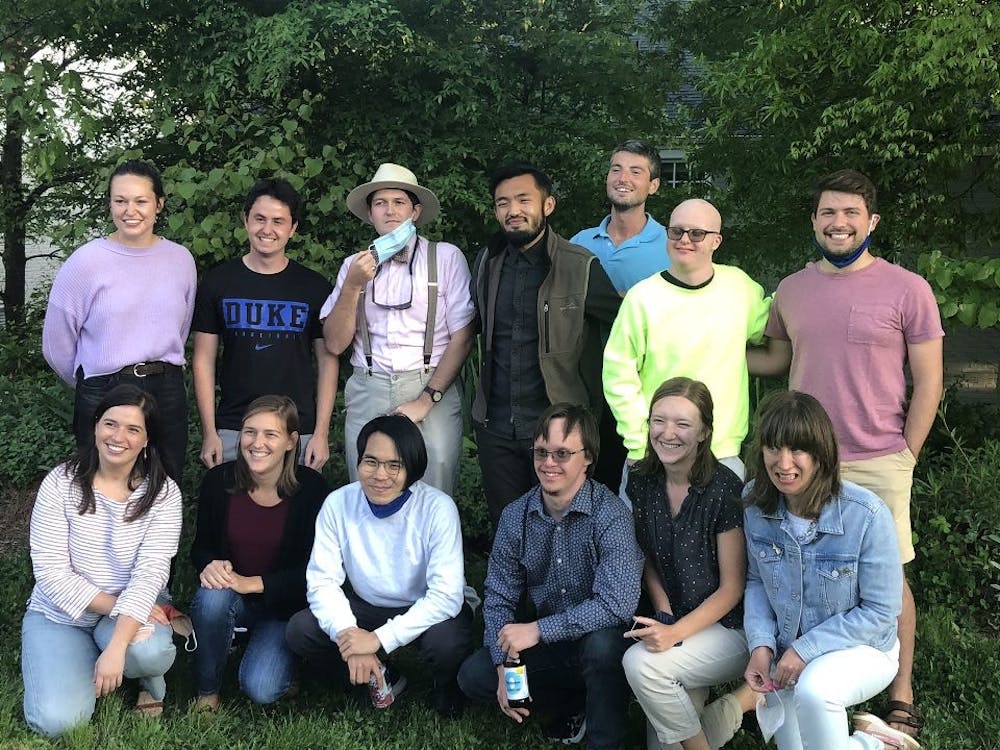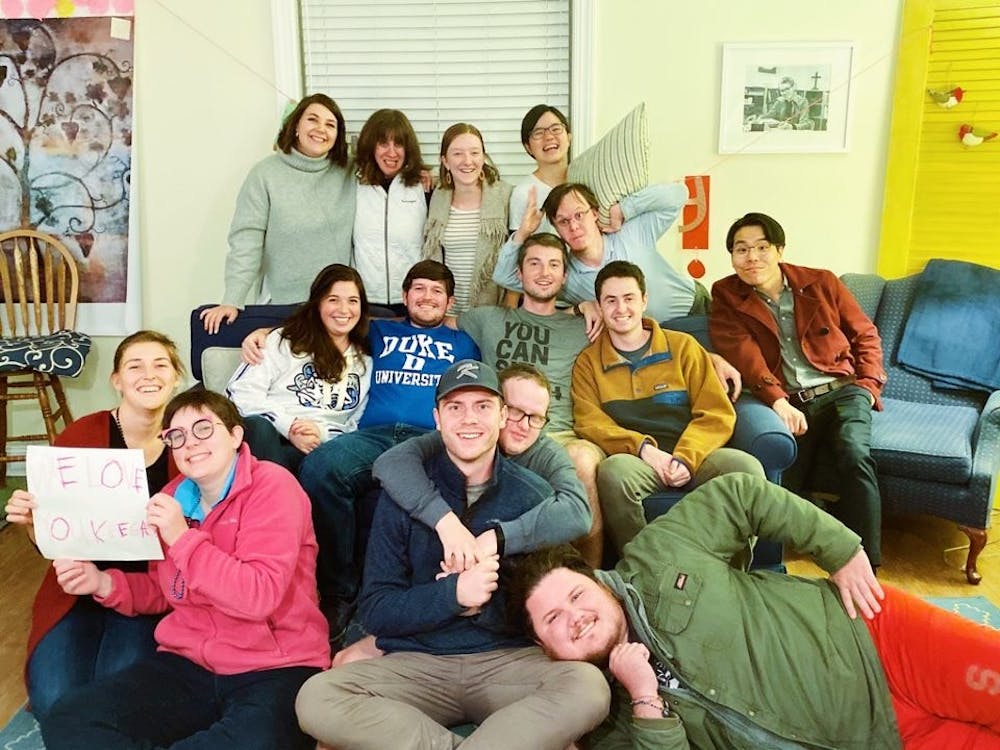Daniel Corpening is waiting for me on grassy, tree-lined Northwood Circle in Durham. Corpening, the director of field education for Duke’s Divinity School, points out two houses on the street.
At first, it doesn’t seem like there’s much to see: just a couple of ordinary two-story houses with brick porches and pumpkins resting on the steps. But these two buildings—304 and 306 Northwood Circle—are part of an intriguing experiment, a network of homes across the country called Friendship Houses. These are homes where young people with and without disabilities eat, pray and celebrate together.
Twelve Duke Divinity School students live in the two houses with four people with intellectual or developmental disabilities. There is a men’s house and a women’s house, each with two apartments. In each apartment, three Divinity students live with a “core resident,” a person with a disability.
The Friendship House—though it’s two houses, it’s called a singular “Friendship House”—is part of a neighborhood of people with and without disabilities. Corpening walks down the street, takes a left, and leads me to the “Corner House,” another community of people with and without disabilities. Both the Friendship House and the Corner House are owned and operated by Reality Ministries, though only the Friendship House partners with the Divinity School.
There are other homes in this area where families have young adults with disabilities, or where adult siblings with and without disabilities live together. Every morning, the community gathers for prayer. It’s a pocket of Durham “committed to the vision of a shared life between people of different abilities,” Corpening says.
The Friendship House is the core of this community, and its advocates believe it has a transformative effect on both the students and the core residents.
“There’s a way in which people are being shaped in who they are by living here in these houses,” Corpening says. “To experience nurturing relationships, caring relationships, loving relationships, it shapes who they are.”
For the Divinity students, the Friendship House is a source of affordable housing—students pay $450 in monthly rent, while core residents pay $400—and an opportunity to grow in empathy. For the core residents, the Friendship House is a place to live independently from their parents. For both, it’s a source of close relationships and intimate community in a world that feels increasingly atomistic.
“Kids with disabilities … they get cut out of an awful lot of stuff, and it’s hard to have community,” said Peter Barnes, the father of Jennifer Barnes, a 32-year-old core resident with autism. “The beauty of Friendship House—and it truly is just a miracle—is that Friendship House, and the North Street community where it’s located, creates just this enormously accepting, welcoming community. And the 12 Divinity students are not taking care of the four core residents and our daughter. They’re friends, and that’s a magnificent thing.”

***
It was the fall of 2014, and the Barnes parents were worried about where Jennifer, who was 25 at the time, would live. They wanted her to be independent, but they didn’t know how or where she would live on her own. Then, the Barnes family heard about Friendship House, which was in its second year at the time. One of the original core residents had just moved out, so there was an open spot. Jennifer moved there in September 2014.
“Parents of kids with disabilities don’t have the luxury that parents of neurotypical children have of just assuming that when they finish school, or whatever that limit is, they’re going to fly the nest,” Peter Barnes said. “And so you’re always thinking about what will work.”
The Barnes family wasn’t alone. More than 6 million people in the United States have a developmental disability, and approximately 6.5 million people have an intellectual disability. Under the United Nations Convention on the Rights of Persons with Disabilities, all people with disabilities have a right to live fully in the community, with choices equal to those of people without disabilities.
But that’s more aspiration than reality. In practice, “individuals with disabilities … often lack the freedom to choose with whom they live and where they reside,” according to an article in the journal Behavior Analysis in Practice. Group homes or other congregate settings with care takers are an option, but independent and semi-independent situations often lead to better outcomes and lower costs.
By age 21, most people with disabilities “age out” of the system of care provided by the state and are left to find their own housing options. The default option for most people with disabilities is to live with their parents. In the U.S., over 70% of adults with disabilities live at home with a parent or sibling, according to Matthew Floding, who helped found the Friendship House in Durham. For adults with intellectual or developmental disabilities, that number is closer to 80%.
When people with intellectual or developmental disabilities live with their parents, they sacrifice what Vicki Smith, the executive director of Alliance of Disability Advocates, calls the “dignity of risk-taking”—being part of a community of peers, having the ability to do social things like watch a basketball game with friends or go out for dinner and, most importantly, experiencing the freedom to make mistakes.
The Friendship House is intended for people who already have some living skills. All the core residents at the Friendship House are able to do things like wash dishes or use the bathroom. Jennifer sets her own alarm, does her laundry, plans her meals, manages her money and purchases groceries.
Get The Chronicle straight to your inbox
Sign up for our weekly newsletter. Cancel at any time.
If Jennifer hadn’t found Friendship House, she’d be still living with her parents or in an apartment situation with a couple of roommates to give her a “semblance of community,” according to the Barnes parents.
“And that would have been the best we could have done and hopefully it would have worked out, but what it isn’t is a critical mass. The challenge is getting a critical mass of people—people who are neurotypical as well as people with disabilities,” Peter said.
People with disabilities who are living on their own often face social exclusion. Physical presence in a neighborhood isn’t enough to guarantee acceptance by that community, according to an article published in the Journal of Intellectual Disabilities.
“[Jennifer] has many capabilities. And she has learned to solve many of her own problems since she has been at Friendship House. But she doesn’t have good social judgment or people judgment,” said Jean Anne Barnes. “I think she would be unsafe if living singularly.”
At the House, people with disabilities hone their independent living skills, immerse themselves in a community and prepare for what’s next. They experience the dignity of risk while also building a network of support.
“I have a place where I know I’m really valued and loved and know I’m an integral part of,” Jennifer said in a video posted by the Divinity School. “I fit in really well with the people there because if I didn’t, I don’t know what I would do with my life.”
***
The first Friendship House started in 2009, when Floding was dean of students at Western Theological Seminary in Holland, Mich., and the seminary was seeking more housing for its students. One day, after a church service, a couple came up to him and said their son with Down syndrome wanted to live independently but had nowhere to go.
“They talked about their fear of group-home situations, where they’d heard some horror stories,” Floding said. “And then just kind of spontaneously, I was like, ‘Well, you have a need for housing, we have a need for housing; let’s put our needs together and see what will happen.’”
After Floding gained approval from the Board of Trustees and helped raise $2.5 million, the first Friendship House was born. It had six apartments, with six core residents and 18 seminary students. Early on, Floding and the residents established shared rhythms, like eating meals together and gathering for prayer.
When Floding came to work at Duke Divinity School a few years later, he began having conversations with the Divinity School staff about creating something similar in Durham.
Around the same time, a group of families affiliated with Reality Ministries—an organization in Durham focused on disability advocacy—had been brainstorming possibilities for a new living situation for their children. One day, in 2012, they gathered with Floding and some Divinity School students in a room in the Reality Center headquarters in downtown Durham. There, they hashed out a plan: Reality Ministries would own the homes, and Divinity students and core residents would rent out the spaces at affordable rates. They eventually raised $750,000 for the first houses.
Greg Little, now director of residential life for Reality Ministries, was one of the first Divinity student residents in the Friendship House.
“I remember feeling this sense … that if [the Friendship House] happens, this will actually be transformative for Duke. The Divinity School will be shifted because of this community,” Little said.
Little was joined by four core residents. Alex Furiness and Nathan Freshwater, who both have Down syndrome, were two of the original residents. Jennifer Barnes joined a little later, and the other apartment has been rotating core residents throughout the years. Early on, Little and the residents decided to establish certain “pillars of life,” including praying together in the mornings, gathering for communal meals and volunteering at Reality Ministries.

Soon, a Friendship House was established in Fayetteville after a Duke alumnus that lived in the Durham house moved there. There are now Friendship Houses at Vanderbilt University in Tennessee; Newberg, Ore.; Terre Haute, Ind.; and even Aberdeen, Scotland. Reality Ministries is only involved with the house in Durham. The others are independently owned and operated: the one in Terre Haute is owned by a church, for instance, while the house at Vanderbilt is owned by a nonprofit.
Friendship House Partners USA is a nonprofit that acts as an advisory group for the various houses. It helps communities establish new houses by providing educational materials and informational sessions about the house model, as well as paying for interested parents and community stakeholders to visit the existing Friendship Houses.
***
One recent Sunday, Freshwater sits cross-legged on the carpet and takes sips from his bowl of chili. He gestures at the circle of residents around him.
“The Friendship House is based on friendship,” he says. “The Friendship House is about how to get involved in developing friends. And how you grow in that ability. It’s the fellowship of people. It’s not just a group, it’s a fellowship. … A group is people inside one room, but with fellowship people come and welcome each other.”
Freshwater and about a dozen other residents have gathered for their weekly communal meal, meeting in a living room on the second floor of the women’s house. The scrumptious smell of chili and fresh-baked scones fills the room as the residents chat and laugh with each other. Freshwater, 32, wears a brown shirt and Crocs.
He tells me he likes coming up with ideas for social events for the community, including his favorite—a movie night in the Bull City. He much prefers living at the Friendship House to living with parents.
“I want to be independent. My parents were happy for me to have an apartment of my own. … I need to take care of my own life. Because that’s [what] my parents raised me to do,” he says.
Most of the core residents have some kind of job or volunteer commitment. Freshwater works as a bagger at Harris Teeter on 9th Street. Furiness, 29, has been volunteering at the Divinity School Library for over a decade.
Each of the two apartments in a house has a similar floor plan: living room, kitchen, dining table and individual rooms with bathrooms. Freshwater shows me his room, which is full of things that reflect his creativity: there’s an open notebook where he jots down ideas and stories, an electric keyboard and lots of speakers. A black-and-white Hollywood clapboard and a book about the Titanic rest on one of his bookshelves.
The Divinity School students only stay at the Friendship House for a few years at a time, while the core residents can stay for as many as 10 years. As a result, the core residents are meant to be the hosts for the Divinity students, the ones who invite the students into their homes and help orient them to Durham.
Living with people with disabilities is “similar but different,” says Camille Frey, one of the residents and also a resident’s assistant for the women’s section of the Friendship House. It’s a place of belonging, where Frey feels that her worth and place in the community don’t depend on achievement.
“Formation through the Friendship House is a recognition of the fact that my goodness comes not from what I’m told is being a successful student or good worker or whatever, but instead is my being,” she says. “And I learned that a lot through the fact that a lot of people with disabilities aren’t offering those same things to the world but that shouldn’t take away from the fact that they’re good people. And that they’re people to begin with.”
The Divinity students aren’t caretakers for the core residents. Instead, the relationships between them and the core residents are meant to be reciprocal, a mutual investment in a community.
Frey has learned to adjust her schedule to fit the needs of the group: sometimes, a quick “How was your day?” turns into a two-hour-long conversation with one of the core residents, even when there are deadlines to meet and assignments to finish—because that’s what community requires.
“I think that living here, you recognize that your life doesn’t belong just to you. You’re interdependent,” says Yudai Chiba, a third-year student in the Divinity school and one of the Divinity student residents. “In modern America, we tend to think of ourselves as individuals, and we can think of our lives as, ‘Hey, I live the way I want.’ But living somewhere like the Friendship House, you realize you’re part of something else too.”
A few years ago, Freshwater and a former resident, Quinn Holmquist, Trinity ‘16, wrote and recorded a “Friendship House anthem.” In a video posted on Facebook, the two sit side by side on a couch, each strumming a guitar and crooning the lyrics to the song: “The welcome comes before the love. Open doors make this apartment like a home.”
Then, they reach the chorus.
“When you have an apartment of your own, when you have roommates…”—their voices grow louder and rise in pitch—“… you’re a part of them, and they’re a part of you.”

Chris Kuo is a Trinity senior and a staff reporter for The Chronicle's 118th volume. He was previously enterprise editor for Volume 117.

